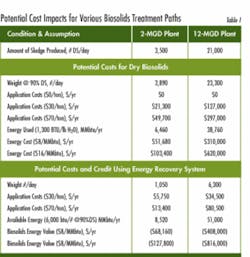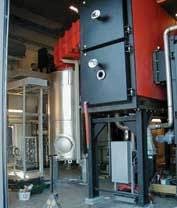Energy Recovery System Harnesses Power of Biosolids
Biosolids drying is energy-intensive and may become more expensive as fuel costs increase. In order to optimize the drying process, energy of the biosolids can be harnessed and cycled back into the system.
To that end, Kruger has developed its BioCon® Energy Recovery System (BERS). The BERS system offers wastewater treatment plants the opportunity to reduce energy costs by feeding the dried biosolids into a Biosolids Furnace equipped with a special heat recovery system. The recovered heat is then returned to the drying process. At this point the drying process becomes completely energy self-sufficient.
An added benefit of the BIOCON ERS is that total material reduction is achieved, reaching greater than 95% solids reduction.
Process Considerations
Class A-designated biosolids have enjoyed a greater public acceptance for land application than Class B biosolids as a result of the minimized risks associated with product exposure, given the lower pathogen levels required to achieve the designation. In addition, the form in which the biosolids are applied affects product acceptability. For instance, land application of dewatered biosolids has greater acceptance than liquid land application, and dried biosolids has the utmost acceptability.
Along with perception issues, disposal of liquid biosolids typically has higher transportation costs. While dewatering and drying biosolids lowers the cost of transportation, the dewatering and drying processes themselves carry an energy price tag.
Regardless of the routes taken (liquid or dry), energy requirements greatly impact treatment and disposal costs. Fuel costs directly correlate with hauling cost, which can be lowered by reducing the amount of water contained in the biosolids. This factor has influenced many municipalities to dewater, or dry, their biosolids.
Drying System
In the BioCon® process, dewatered sludge cake is pumped through sludge depositors onto a slow moving belt, where it is dried to approximately 55% DS before transferring to a second belt for final drying to 90% DS. The dried sludge is transported out of the dryer by a screw conveyor to a solids buffer tank.
The energy for the drying process is supplied by the BioCon® biosolids furnace. A general process flow diagram for the BioCon® is provided in Figure 1. Heat from the biosolids furnace is transferred to the dryer process via a circulation fan and heat exchangers. A condenser is provided to remove evaporated water from the drying air.
The BioCon® furnace features a slow-moving, water-cooled grate furnace. Air is blown over and through the grate to insure maximum reduction of organic material. Off-gas, after being treated with lime or sodium bicarbonate and sent to a bag filter, is released through a stack.
By implementing an energy recovery system, the amount of material to be transported out of a plant is significantly reduced, resulting in lower hauling costs. Further, the risk associated with the cost of fuel is removed.
For more information about the Kruger BioCon BERS, contact Brian Frewerd at 919-677-8310, or visit the company’s website at www.krugerusa.com.


